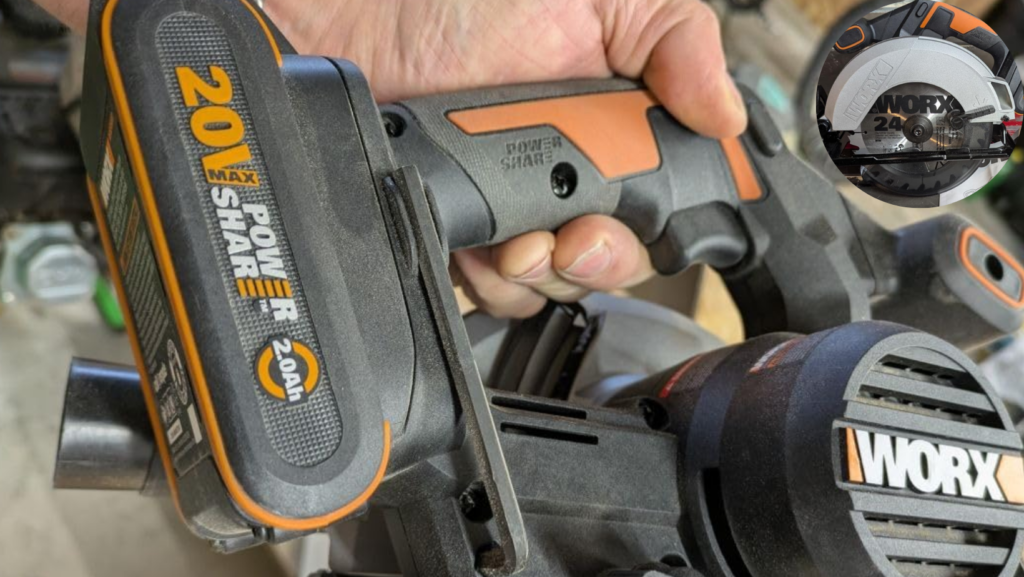The first time I picked out a circular saw, I stood there confused. So many blade sizes—and I had no clue what I was looking at. I just wanted something that could cut clean and get the job done. Choosing the right size isn’t just about numbers. It’s about how deep it cuts, how heavy it feels, and how much power you need. In this guide, I’ll keep it simple. We’ll go over blade sizes, compare the circular saw 6 1/2 vs 7 1/4, look at typical circular saw blade thickness, and clear up terms like round saw and standard skill saw blade size. Let’s make sure you get the right one the first time.
What Size Circular Saw Do You Really Need?
Wondering what size circular saw to use? It all comes down to what you’re cutting and how often you plan to use it. Circular saw sizes are based on blade diameter. That number—like 6 1/2 or 7 1/4 inches—shows how deep the saw can cut. The bigger the blade, the deeper the cut.
The most common sizes are 6 1/2-inch and 7 1/4-inch. These work great for most people. A 7 1/4-inch saw is the standard on many job sites. It cuts deeper and handles bigger jobs. If you’re framing, building decks, or doing heavy work, this one is a solid pick. What Size Circular Saw
For light home jobs, a 6 1/2-inch saw works well. It’s smaller, lighter, and easy to use. Think of it like using a small knife for a small job—it just makes sense. If you need more power and depth, go bigger.
To keep it simple: use a 7 1/4-inch saw for big tasks and a 6 1/2-inch for small ones. Match the saw to the job, and you’ll make cleaner, faster cuts every time.

What Is the Typical Circular Saw Blade Size?
When you’re picking a saw blade, you’ll see two sizes a lot: 6 1/2-inch and 7 1/4-inch. These are the most used. A 6 1/2-inch blade is lighter and easier to handle. It’s great for small jobs at home—like cutting shelves or trim. What Size Circular Saw.
A 7 1/4-inch blade can cut deeper. It’s better for big tasks, like cutting 2x4s or thick wood. This size is common on job sites. It’s strong and easy to find at stores.
Some blades are smaller—like 4 1/2 inches. These work for tight spaces but can’t cut deep. Larger blades, like 10 1/4 inches, are used for big, heavy-duty jobs.
Standard Skill Saw Blade Size
A skill saw is just another name for a basic circular saw. Most of these use a 7 1/4-inch blade. It’s the most common and the easiest to find.
This blade cuts deep enough for most tasks. It’s great for framing, cutting wood for decks, or DIY jobs around the house. It’s strong, reliable, and ready for big work. What Size Circular Saw.
What’s the Typical Circular Saw Blade Thickness?
Let’s talk about blade thickness. It’s called the kerf. That just means how wide the blade cuts.
When I first started, I didn’t know this mattered. But I soon learned that the blade’s thickness can change how your saw works.
Thin Blades vs. Thick Blades
Thin blades are great for small saws. They don’t need much power. They cut fast and smooth. If you’re using a cordless saw, this is the blade you want.
Thick blades are strong. They hold up better when cutting hard wood. They don’t bend as much. I use thick blades when I’m cutting heavy boards or framing.
Which Should You Choose?
For home jobs or small saws, I like thin blades. They make clean cuts and save battery. But for big cuts, thick blades are worth it. They don’t wear out as fast.
I keep both types in my toolbox. Each one has its place.

Round Saw vs Circular Saw – Is There a Difference?
When I first heard someone say round saw, I thought they meant a whole different tool. I looked around, thinking, Did I miss something? But no—turns out, it’s the same tool I already had in my hand.
A round saw is just a casual way to say circular saw. Nothing fancy. Just a nickname.
The word circular comes from the shape of the blade. It spins in a circle. That’s all. Some folks also say “skill saw,” which comes from the brand Skilsaw. They made the first ones way back. The name stuck.
So if someone says grab the round saw, they mean the circular saw. No need to overthink it.
Don’t worry about the names. What matters is how you use it—and choosing the right one for your job.
Factors to Consider Before Choosing Your Circular Saw Size
Not sure which saw to get? Don’t worry. Let’s make it easy. Here are the key things to think about before you pick a size.
What Are You Cutting?
Cutting thin wood or soft boards? A small saw like a 6 1/2-inch will do fine. It’s light and easy to use.
Cutting thick boards or hardwood? Go bigger. A 7 1/4-inch saw cuts deeper and has more power.
How Often Will You Use It?
Just working on small home jobs now and then? A light saw is perfect. You don’t need anything big.
Using it a lot or on job sites? Get one that’s tough. A bigger saw can handle more work.
Are You New or Have You Used One Before?
If you’re new, start small. A light saw is easy to hold and safer to use. You’ll learn fast and stay in control.
If you’ve used saws before, you may want more size and power. Pick the one that feels right in your hands.
What’s Your Budget?
Trying to save money? A 6 1/2-inch saw is cheaper and works for most home tasks.
Want to spend more for long-term use? A good 7 1/4-inch saw can last years and handle bigger jobs.
Quick Checklist to Help You Choose
- ✅ Cutting small stuff? → Go with 6 1/2-inch.
- ✅ Doing big work? → Choose 7 1/4-inch or more.
- ✅ Not using it much? → A light saw is best.
- ✅ Using it a lot? → You’ll want more power.
- ✅ New to saws? → Start small and safe.
- ✅ On a budget? → Smaller saws save cash.
- ✅ Want to grow with it? → Get one that can keep up.
Pick a saw that fits you. Think about what you’re cutting, how often, and your skill level. A good saw makes your work faster, cleaner, and way more fun.
My Recommendation Based on Years of Use
If I had to pick one saw to use every day, I’d go with the 7 1/4-inch. It’s strong, fast, and gets the job done. I’ve used it for decks, framing, and cutting thick wood. It cuts deep and never lets me down.
But I also like the 6 1/2-inch. It’s light, easy to move, and great for smaller work. I grab it when I’m doing trim, shelves, or anything quick. It feels nice in your hand and doesn’t wear you out.
My Go-To Saws
- DeWalt 7 1/4-inch – Strong, tough, and lasts a long time. I’ve dropped it and it still runs great.
- Makita 6 1/2-inch – Light and smooth. Perfect for easy cuts.
- Skilsaw 7 1/4-inch (corded) – Old-school but super solid for heavy work.
I’ve used both for years. Pick the one that fits your job—and how it feels in your hands. A saw should work with you, not against you.
FAQs About Circular Saw Sizes
What is the best circular saw size for beginners?
Go with a 6 1/2-inch saw.
It’s light, easy to hold, and simple to use. When I was new, this size helped me feel safe and steady. You’ll learn faster with less weight in your hands.
Can a 6 1/2 circular saw cut through a 2×4?
Yes, it can.
I’ve used mine on 2x4s many times. Just set the blade deep enough. It’ll get through with no problem if your blade is sharp.
Is 7 1/4 better than 6 1/2?
It depends.
The 7 1/4-inch saw cuts deeper. It’s stronger for big jobs. The 6 1/2-inch is lighter and easier to carry. I use both, based on what I’m working on.
Does blade thickness matter?
Yes, it does.
Thin blades cut smooth and fast. They need less power, so they work well on cordless saws. Thick blades are stronger. They’re better for tough cuts.
Are circular saw blades universal?
Not always.
Blades come in different sizes. They also have different center holes. Always check your saw’s size before buying.
What size blade does a skill saw use?
Most use a 7 1/4-inch blade.
That’s the standard size. I use mine for decks, frames, and heavy jobs. It’s strong and easy to find in stores.
Conclusion: Pick the Saw That Fits You
If you’re doing small cuts at home, a 6 1/2-inch saw is great. It’s light, quick, and easy to hold.
If you’re cutting thick wood or building something big, go with a 7 1/4-inch. It’s strong, deep, and made for tough work.
I’ve used both for years. Each one has its place. When I build a deck, I grab my 7 1/4. When I trim shelves or cut boards in the garage, I use my 6 1/2.
Both get the job done—just in different ways.

Hi, I’m Tom Scalisi, and welcome to The Saw Blog! I started this blog to share my hands-on experience and insights about woodworking tools—especially saws and saw blades. Over the years, I’ve had the chance to work with a wide range of tools, and I’m here to help both professionals and hobbyists make informed decisions when it comes to selecting and using their equipment. Whether you’re looking for in-depth reviews, tips, or just advice on how to get the best performance out of your tools, you’ll find it here. I’m excited to be part of your woodworking journey!
